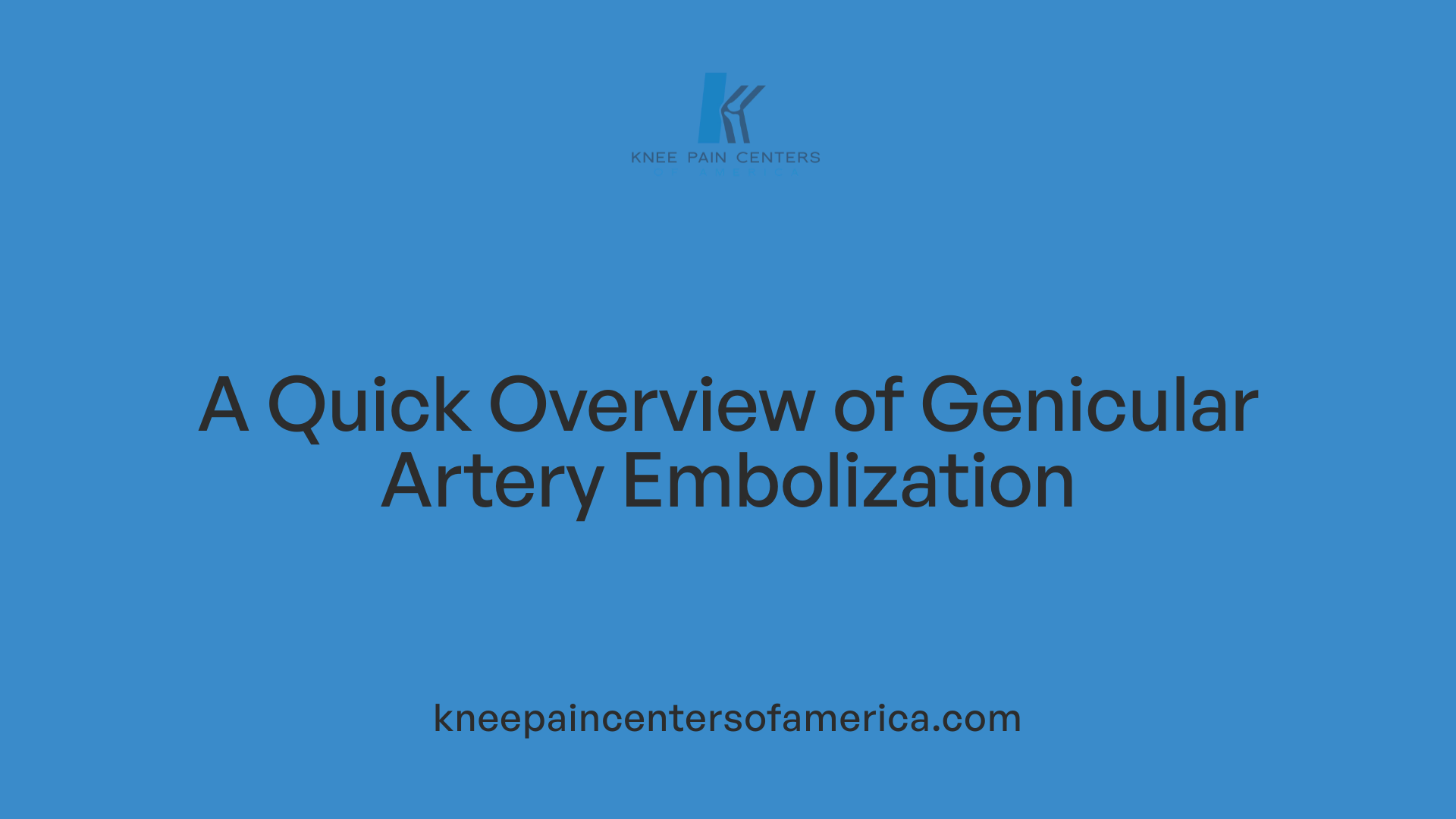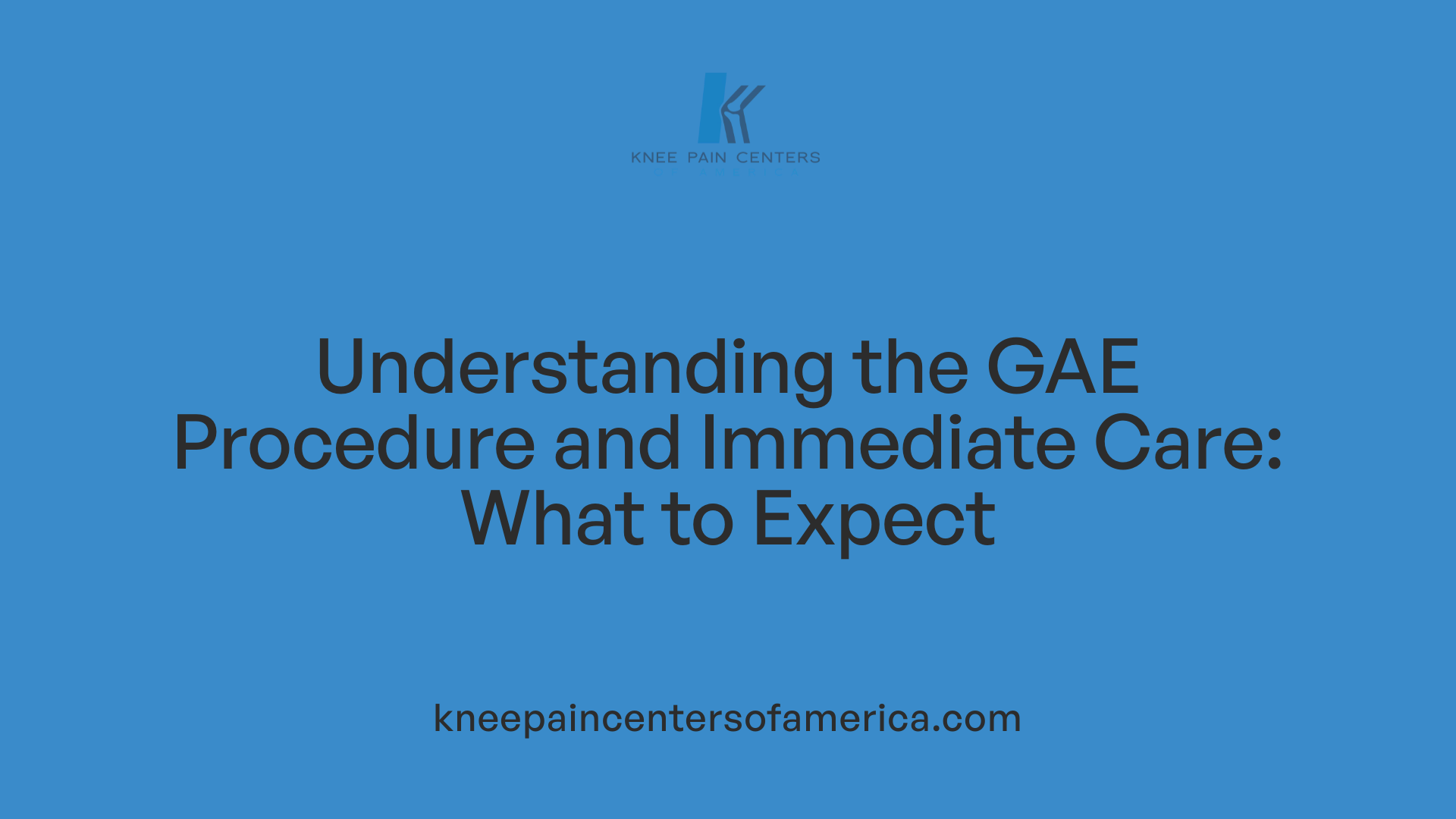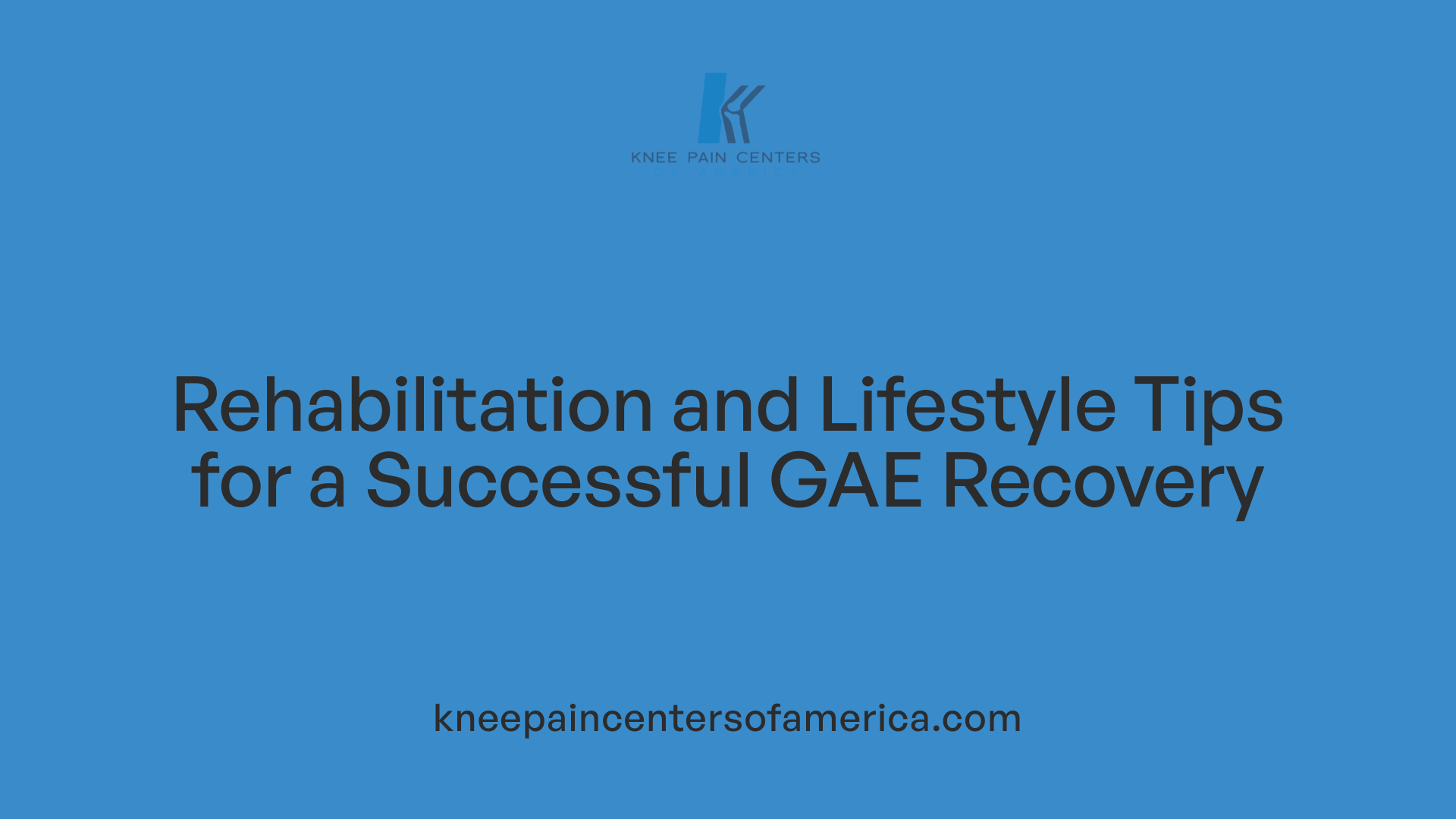Understanding Genicular Artery Embolization and Its Role in Knee Osteoarthritis Management
Genicular artery embolization (GAE) is a minimally invasive procedure emerging as a viable treatment option for patients suffering from moderate to severe knee osteoarthritis, particularly for those looking to avoid or delay knee replacement surgery. This article explores the recovery timeline after GAE, detailing what patients can expect, how to manage recovery, and the long-term benefits of this innovative therapy.
Overview of Genicular Artery Embolization

What is Genicular Artery Embolization and What Is Its Purpose?
Genicular artery embolization (GAE) is a minimally invasive treatment designed to ease knee pain caused by osteoarthritis. It aims to reduce inflammation and alleviate discomfort by targeting specific blood vessels connected to the knee.
How Does GAE Work?
During GAE, tiny particles are injected through a catheter into the genicular arteries that supply blood to the inflamed knee tissues. This blocks blood flow to these areas, decreasing inflammation and pain. The procedure is typically done under local anesthesia with mild sedation and generally takes about one to two hours.
Who Is a Candidate for GAE?
GAE is suitable for adults aged 40 to 80 suffering from moderate to severe knee osteoarthritis who have not found relief through conventional treatments or who wish to avoid knee replacement surgery. It is particularly beneficial for those at higher risk of surgical complications.
How Does GAE Compare to Other Treatments?
Unlike traditional options such as medication, physical therapy, corticosteroid injections, or knee replacement surgery, GAE offers a targeted approach that is less invasive with quicker recovery times. Patients can often resume light activities within a day or two and experience significant pain relief that may last from several months to years. This makes GAE an appealing alternative for managing knee osteoarthritis pain without major surgery.
| Aspect |
GAE |
Traditional Treatments |
Surgical Knee Replacement |
| Invasiveness |
Minimally invasive |
Non-invasive (meds, therapy) or moderately invasive (injections) |
Highly invasive |
| Recovery Time |
1-2 weeks |
Varies; often ongoing |
Several weeks to months |
| Pain Relief Duration |
Months to years |
Temporary, often requiring repeated doses |
Potentially permanent |
| Suitability |
Moderate to severe cases, high-risk surgical candidates |
Mild to moderate cases |
Severe cases |
GAE represents a valuable option for patients seeking effective knee pain relief with less downtime and fewer risks than conventional surgery.
The Genicular Artery Embolization Procedure and Immediate Post-Procedure Care

Procedure Duration and Sedation
Genicular Artery Embolization (GAE) is a minimally invasive procedure that typically takes between one and two hours to complete. It is performed under local anesthesia combined with light sedation, allowing patients to remain comfortable while awake. This approach avoids the risks associated with general anesthesia.
How the Catheter and Particles Work
During GAE, a small catheter is inserted into the blood vessels, usually via the upper leg. Guided by imaging technology, tiny gel particles are then injected into the genicular arteries that supply blood to the inflamed knee tissues. These particles block the blood flow to areas affected by osteoarthritis, reducing inflammation and alleviating pain without damaging surrounding tissues or bones.
Same-Day Discharge
One of the advantages of GAE is that it is performed on an outpatient basis. Patients typically spend a short recovery period of about 1.5 hours after the procedure and can return home the same day. This rapid turnaround reduces hospital stays and promotes a quicker return to daily activities.
Initial Post-Procedure Care Recommendations
Immediately following GAE, patients are advised to rest for 24 to 48 hours and apply ice packs to manage knee soreness. Light activities such as gentle walking or stretching can be resumed as soon as the day after the procedure. It is important to follow the pain management instructions provided by healthcare professionals and avoid strenuous activities like heavy lifting or prolonged stair climbing for about a week. This careful balance of rest and gradual movement supports healing and optimal recovery outcomes.
Recovery Timeline After GAE: From Day One to Two Weeks

Observation and Discharge Same Day
Genicular artery embolization (GAE) is a minimally invasive outpatient procedure that generally takes about 1 to 2 hours. After the procedure, patients are typically observed for a short period and can return home the same day. This quick discharge is one of the advantages over traditional knee surgeries.
Resumption of Light Activities
Most patients can begin light activities as soon as the day after having the procedure. Activities such as gentle walking and stretching help with recovery and prevent stiffness, while rest is still essential during the initial 24-48 hours, combined with icing and pain management as advised by healthcare providers.
Expected Soreness and Swelling Duration
Patients commonly experience mild knee soreness and swelling for about three to five days post-procedure. This discomfort is usually manageable and reflects the body's response to the embolization technique. Proper rest and gradual movement during this period promote healing.
Return to Full Activities With Precautions
Within approximately three days, patients can resume normal activities, though it is recommended to avoid prolonged stair climbing and heavy lifting to prevent undue stress on the knee joint. Gradually increasing activity levels while monitoring symptoms helps ensure a safe recovery.
Typical Recovery Completion Timeframe and Symptom Relief
By about two weeks after GAE, most patients experience significant reductions in knee pain, swelling, and stiffness. Mobility improves noticeably, and many report decreased reliance on pain medications. Full recovery with lasting symptomatic relief can extend up to one year or more, giving patients durable benefits from the treatment.
Rehabilitation and Lifestyle Changes Supporting Recovery

What role does physical therapy play in treating knee osteoarthritis?
Physical therapy is essential in improving joint function and managing knee osteoarthritis. After genicular artery embolization (GAE), gentle movements such as stretching and short walks help facilitate recovery by reducing stiffness and strengthening the muscles around the knee. Physical therapists guide patients through progressive exercises that focus initially on mobility and flexibility, gradually advancing to strength and stamina training. This approach not only alleviates pain but also supports better knee stability and reduces the risk of further joint damage.
How can diet support tissue repair and reduce inflammation?
A balanced diet rich in lean proteins, vitamins C and D, and calcium plays a vital role in tissue repair and inflammation reduction post-GAE. Adequate protein intake supports muscle recovery, while vitamins C and D help with collagen synthesis and immune function. Proper hydration complements these benefits by maintaining tissue elasticity and promoting healing.
What long-term lifestyle adjustments help maintain knee health?
Long-term management of knee osteoarthritis involves lifestyle changes that include weight management, regular low-impact exercise such as swimming or walking, and adopting an anti-inflammatory diet. Maintaining a healthy weight can drastically reduce knee joint pressure, easing pain and slowing disease progression. Avoiding high-impact activities and incorporating water-based exercises can further protect the knee while improving strength.
How should patients monitor for complications and when is medical advice necessary?
Monitoring for signs such as increased pain, swelling, redness, fever, or unusual discomfort is important after GAE. While minor soreness and swelling are normal, symptoms like infection or excessive bleeding require prompt medical attention. Patients are encouraged to follow their healthcare provider’s instructions closely and report any concerning signs early to ensure timely care and successful recovery.
Expected Outcomes and Long-Term Benefits of GAE

Duration and Extent of Pain Relief
Genicular artery embolization (GAE) offers significant pain relief for patients with knee osteoarthritis, often reducing pain levels by 50-70%. Many experience noticeable improvement within two weeks, with benefits lasting from several months up to two years. A notable study reported at least a 61% reduction in pain one year after the procedure, highlighting the durability of symptom relief.
Reduced Reliance on Pain Medications
By targeting the inflamed blood vessels supplying the knee, GAE helps decrease inflammation and stiffness. This often enables patients to lower their dependence on pain medications, allowing more engagement in physical therapy and daily activities with less discomfort.
Improved Mobility and Function
Patients typically regain improved knee mobility and reduced stiffness post-GAE. Most are able to resume light activities within a day or two, returning to full activity levels within about three days while avoiding strenuous exertion. Enhanced mobility contributes to better overall function and quality of life.
Comparison with Knee Replacement Surgery and Other Treatments
Knee replacement surgery is generally considered when conservative measures like medications, physical therapy, and corticosteroid injections fail to alleviate severe pain and functional impairment due to advanced osteoarthritis. Corticosteroid injections provide temporary relief by reducing joint inflammation but are limited in duration.
GAE emerges as a less invasive alternative, especially suitable for patients with moderate to severe arthritis pain who are not ideal candidates for or wish to avoid surgery. The procedure features shorter recovery time, minimal wound care, and outpatient treatment advantages.
Potential Risks and Management
While GAE is minimally invasive, it carries some risks such as temporary pain, swelling, bruising, allergic reactions to contrast dye, and rare localized tissue ischemia. These complications are generally manageable with appropriate follow-up care and monitoring. Patients are advised to rest, gradually increase activity, and seek prompt medical attention if signs like excessive pain or infection appear.
Looking Ahead: Embracing Recovery After Genicular Artery Embolization
Genicular artery embolization represents a promising advancement in the treatment of knee osteoarthritis, combining effective pain relief with a minimally invasive approach and rapid recovery timeline. Patients can expect to resume light activities shortly after the procedure, with significant symptom improvements typically within two weeks. Through careful post-procedure care, physical therapy, and healthy lifestyle changes, individuals can maximize their outcomes and enjoy sustained relief from knee pain. While GAE is not a cure-all, it offers a valuable option for those seeking alternatives to surgery, improving both mobility and quality of life with manageable risks and a relatively gentle recovery process.
References